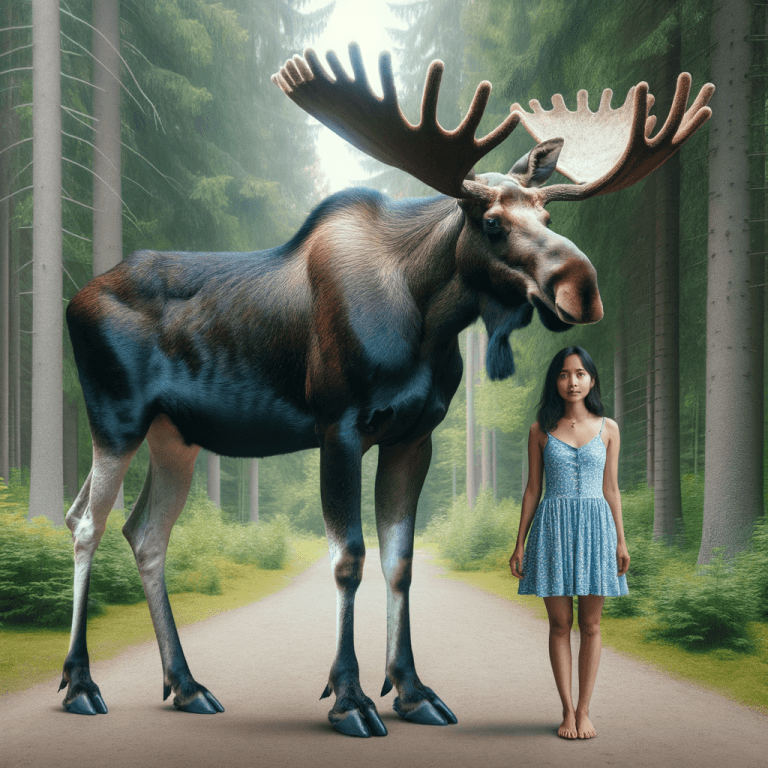Understanding Moose: A Comparison to Humans
When it comes to size, a moose is a true giant compared to a human. Standing at an average of 6-7 feet (1.8-2.1 meters) tall and weighing 800-1,200 pounds (360-540 kilograms), these majestic creatures are truly awe-inspiring. Their behavior and habitat are equally fascinating, making them a captivating subject to explore.
Discover the Surprising Similarities and Differences Between Moose and Humans
Find out how the size and weight of a moose compares to that of a human, and be amazed by the fascinating facts that will leave you wanting to learn more about these incredible creatures.
Moose Size
When comparing the average size of a moose to that of a human, it becomes evident that moose are significantly larger in both height and weight. A typical adult moose stands at around 6-7 feet (1.8-2.1 meters) at the shoulder, while an average human stands at approximately 5-6 feet (1.5-1.8 meters). In terms of weight, a moose can weigh anywhere from 800-1,200 pounds (360-540 kilograms), whereas the average human weighs around 137-187 pounds (62-85 kilograms).
Comparison Table
| Height (feet) | Weight (pounds) | |
|---|---|---|
| Moose | 6-7 | 800-1,200 |
| Human | 5-6 | 137-187 |
As we can see from the comparison, moose are notably larger than humans in both height and weight, making them one of the largest land animals in North America.
Moose Behavior
When it comes to moose behavior, these majestic creatures exhibit a range of characteristics that distinguish them from humans. Here are some key points to consider:
- Moose are solitary animals, preferring to roam alone or in small groups, unlike humans who thrive in social settings.
- During mating season, male moose engage in aggressive behavior to establish dominance and attract females, a behavior not commonly observed in humans.
- Moose are known to be territorial and can display defensive behavior when feeling threatened, a trait not typically seen in humans.
- These animals are also adept swimmers and are often found in aquatic environments, showcasing a behavior that sets them apart from humans.
Understanding the behavioral patterns of moose in their natural habitat provides valuable insight into their unique characteristics and lifestyle compared to humans.
Moose Habitat
One of the most fascinating aspects of moose is their unique habitat. These majestic creatures are commonly found in the northern regions of North America, including Canada, Alaska, and the northern United States. They are also prevalent in parts of Europe and Asia, such as Scandinavia and Russia.
Distinct Habitats
Within these geographical locations, moose thrive in a variety of habitats, including:
- Boreal forests
- Wetlands
- Mountains
These diverse environments provide the necessary resources for moose to survive and thrive, including ample vegetation for grazing and access to water sources.
When comparing the habitat of moose to that of humans, it becomes evident that moose have adapted to thrive in more rugged and remote areas, away from human civilization. Their ability to navigate and thrive in these natural environments is a testament to their resilience and unique characteristics as a species.
 Moose Facts
Moose Facts
As we delve deeper into the world of moose, there are some fascinating and lesser-known facts that shed light on the unique nature of these majestic creatures. Here are some key moose facts to consider:
- Moose Size Comparison: The average adult moose stands at an impressive 6-7 feet (1.8-2.1 meters) at the shoulder, towering over the average human height of 5.6 feet (1.7 meters). In terms of weight, moose can weigh anywhere from 800-1,200 pounds (360-540 kilograms), far surpassing the average human weight of 137 pounds (62 kilograms).
- Moose Antlers: Male moose, known as bulls, possess impressive antlers that can span up to 6 feet (1.8 meters) in width. These antlers serve as a symbol of dominance and are shed and regrown annually.
- Moose Diet: Despite their large size, moose are primarily herbivores, feeding on a diet of aquatic plants, shrubs, and tree bark. Their specialized digestive system allows them to extract nutrients from tough, fibrous vegetation.
- Moose Swimming Ability: Moose are excellent swimmers and are known to traverse bodies of water with ease. Their long legs and streamlined bodies make them well-adapted for aquatic travel.
- Moose Vocalizations: While moose are generally solitary animals, they communicate through a series of vocalizations including grunts, bellows, and low-pitched calls. These vocalizations play a crucial role in mating and territorial disputes.
These intriguing facts provide a glimpse into the remarkable characteristics and behaviors of moose, offering a deeper understanding of their natural prowess and adaptability in the wild.
Conclusion
In conclusion, this article has provided a comprehensive overview of moose, covering their size, behavior, habitat, and interesting facts. The comparison of moose size to that of a human naturally highlights the impressive stature of these animals. The discussion of moose behavior in their natural habitat further emphasizes the distinct characteristics that set them apart from humans.
The description of moose habitats and the specific environmental requirements of moose offers insight into the unique needs of these animals. The presentation of interesting and lesser-known facts about moose, including their scientific and technical terms, adds depth to the understanding of these fascinating creatures.
Overall, this article serves its primary purpose of informing and educating readers about moose in a clear, straightforward, and concise manner. It encourages readers to further explore the topic of moose and provides a well-structured and informative guide for a broad audience interested in learning about these majestic animals.


Comments are closed.